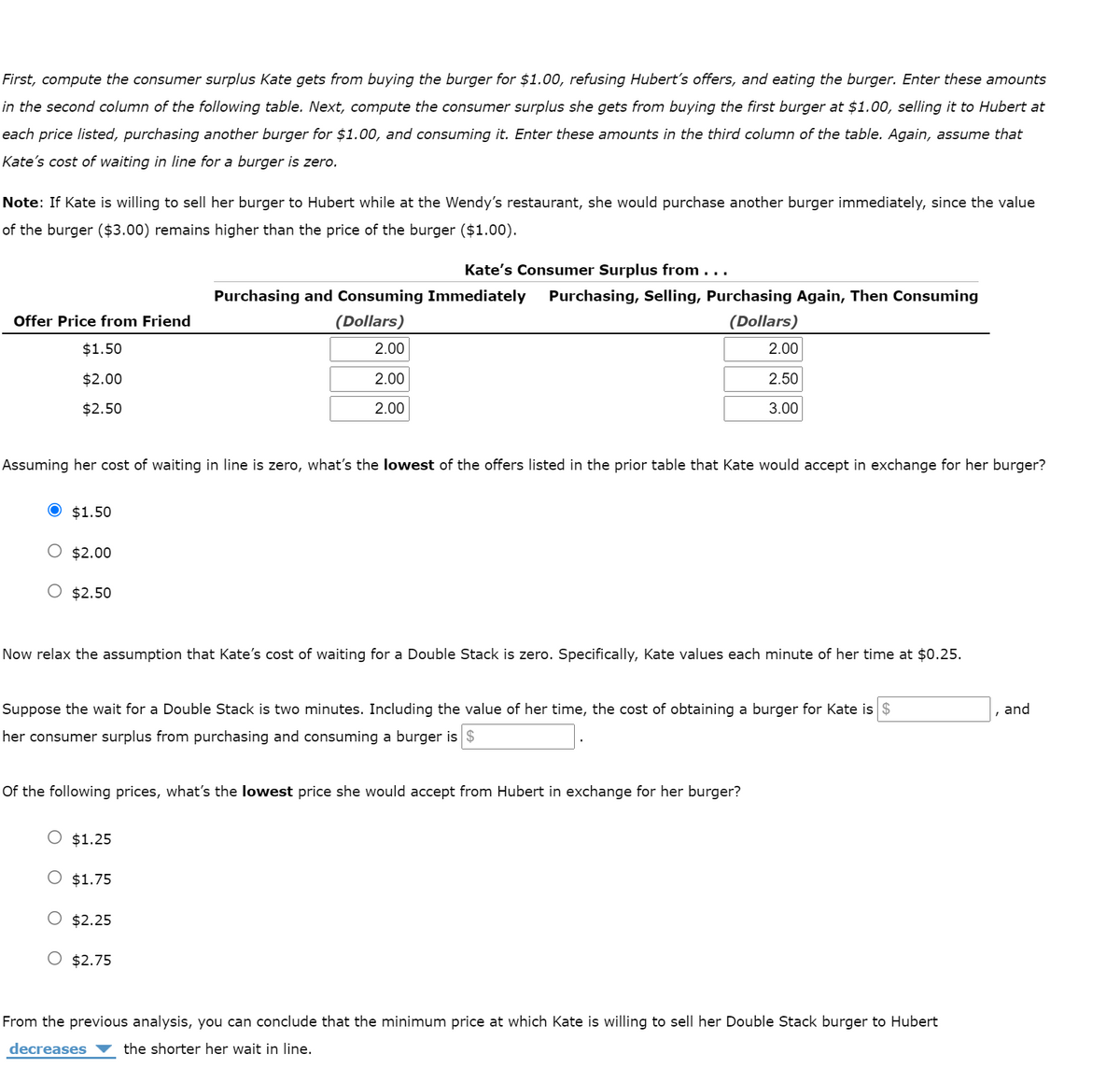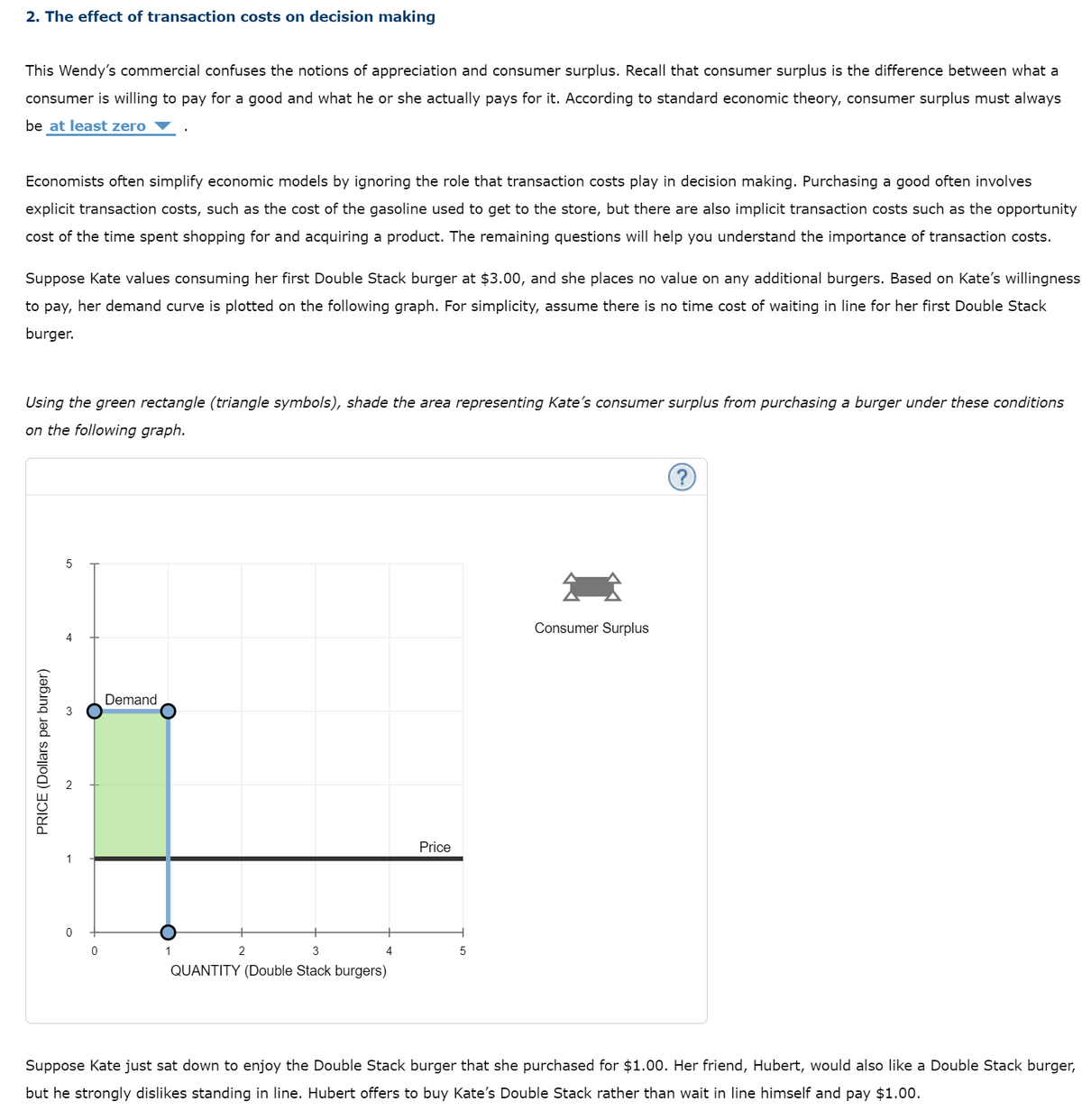This Wendy's commercial confuses the notions of appreciation and consumer surplus. Recall that consumer surplus is the difference between what a consumer is willing to pay for a good and what he or she actually pays for it. According to standard economic theory, consumer surplus must always be at least zero Economists often simplify economic models by ignoring the role that transaction costs play in decision making. Purchasing a good often involves explicit transaction costs, such as the cost of the gasoline used to get to the store, but there are also implicit transaction costs such as the opportunity cost of the time spent shopping for and acquiring a product. The remaining questions will help you understand the importance of transaction costs. Suppose Kate values consuming her first Double Stack burger at $3.00, and she places no value on any additional burgers. Based on Kate's willingness to pay, her demand curve is plotted on the following graph. For simplicity, assume there is no time cost of waiting in line for her first Double Stack burger. Using the green rectangle (triangle symbols), shade the area representing Kate's consumer surplus from purchasing a burger under these conditions on the following graph.
This Wendy's commercial confuses the notions of appreciation and consumer surplus. Recall that consumer surplus is the difference between what a consumer is willing to pay for a good and what he or she actually pays for it. According to standard economic theory, consumer surplus must always be at least zero Economists often simplify economic models by ignoring the role that transaction costs play in decision making. Purchasing a good often involves explicit transaction costs, such as the cost of the gasoline used to get to the store, but there are also implicit transaction costs such as the opportunity cost of the time spent shopping for and acquiring a product. The remaining questions will help you understand the importance of transaction costs. Suppose Kate values consuming her first Double Stack burger at $3.00, and she places no value on any additional burgers. Based on Kate's willingness to pay, her demand curve is plotted on the following graph. For simplicity, assume there is no time cost of waiting in line for her first Double Stack burger. Using the green rectangle (triangle symbols), shade the area representing Kate's consumer surplus from purchasing a burger under these conditions on the following graph.
Principles of Economics (MindTap Course List)
8th Edition
ISBN:9781305585126
Author:N. Gregory Mankiw
Publisher:N. Gregory Mankiw
Chapter7: Consumers, Producers, And The Efficiency Of Markets
Section: Chapter Questions
Problem 6PA
Related questions
Question

Transcribed Image Text:First, compute the consumer surplus Kate gets from buying the burger for $1.00, refusing Hubert's offers, and eating the burger. Enter these amounts
in the second column of the following table. Next, compute the consumer surplus she gets from buying the first burger at $1.00, selling it to Hubert at
each price listed, purchasing another burger for $1.00, and consuming it. Enter these amounts in the third column of the table. Again, assume that
Kate's cost of waiting in line for a burger is zero.
Note: If Kate is willing to sell her burger to Hubert while at the Wendy's restaurant, she would purchase another burger immediately, since the value
of the burger ($3.00) remains higher than the price of the burger ($1.00).
Kate's Consumer Surplus from ...
Purchasing and Consuming Immediately
Purchasing, Selling, Purchasing Again, Then Consuming
Offer Price from Friend
(Dollars)
(Dollars)
$1.50
2.00
2.00
$2.00
2.00
2.50
$2.50
2.00
3.00
Assuming her cost of waiting in line is zero, what's the lowest of the offers listed in the prior table that Kate would accept in exchange for her burger?
$1.50
O $2.00
O $2.50
Now relax the assumption that Kate's cost of waiting for a Double Stack is zero. Specifically, Kate values each minute of her time at $0.25.
Suppose the wait for a Double Stack is two minutes. Including the value of her time, the cost of obtaining a burger for Kate is $
, and
her consumer surplus from purchasing and consuming a burger is $
Of the following prices, what's the lowest price she would accept from Hubert in exchange for her burger?
O $1.25
O $1.75
O $2.25
O $2.75
From the previous analysis, you can conclude that the minimum price at which Kate is willing to sell her Double Stack burger to Hubert
decreases
the shorter her wait in line.

Transcribed Image Text:2. The effect of transaction costs on decision making
This Wendy's commercial confuses the notions of appreciation and consumer surplus. Recall that consumer surplus is the difference between what a
consumer is willing to pay for a good and what he or she actually pays for it. According to standard economic theory, consumer surplus must always
be at least zero
Economists often simplify economic models by ignoring the role that transaction costs play in decision making. Purchasing a good often involves
explicit transaction costs, such as the cost of the gasoline used to get to the store, but there are also implicit transaction costs such as the opportunity
cost of the time spent shopping for and acquiring a product. The remaining questions will help you understand the importance of transaction costs.
Suppose Kate values consuming her first Double Stack burger at $3.00, and she places no value on any additional burgers. Based on Kate's willingness
to pay, her demand curve is plotted on the following graph. For simplicity, assume there is no time cost of waiting in line for her first Double Stack
burger.
Using the green rectangle (triangle symbols), shade the area representing Kate's consumer surplus from purchasing a burger under these conditions
on the following graph.
Consumer Surplus
Demand
Price
1
1
2
3
5
QUANTITY (Double Stack burgers)
Suppose Kate just sat down to enjoy the Double Stack burger that she purchased for $1.00. Her friend, Hubert, would also like a Double Stack burger,
but he strongly dislikes standing in line. Hubert offers to buy Kate's Double Stack rather than wait in line himself and pay $1.00.
PRICE (Dollars per burger)
Expert Solution
This question has been solved!
Explore an expertly crafted, step-by-step solution for a thorough understanding of key concepts.
This is a popular solution!
Trending now
This is a popular solution!
Step by step
Solved in 4 steps with 1 images

Knowledge Booster
Learn more about
Need a deep-dive on the concept behind this application? Look no further. Learn more about this topic, economics and related others by exploring similar questions and additional content below.Recommended textbooks for you

Principles of Economics (MindTap Course List)
Economics
ISBN:
9781305585126
Author:
N. Gregory Mankiw
Publisher:
Cengage Learning

Principles of Microeconomics (MindTap Course List)
Economics
ISBN:
9781305971493
Author:
N. Gregory Mankiw
Publisher:
Cengage Learning

Principles of Macroeconomics (MindTap Course List)
Economics
ISBN:
9781285165912
Author:
N. Gregory Mankiw
Publisher:
Cengage Learning

Principles of Economics (MindTap Course List)
Economics
ISBN:
9781305585126
Author:
N. Gregory Mankiw
Publisher:
Cengage Learning

Principles of Microeconomics (MindTap Course List)
Economics
ISBN:
9781305971493
Author:
N. Gregory Mankiw
Publisher:
Cengage Learning

Principles of Macroeconomics (MindTap Course List)
Economics
ISBN:
9781285165912
Author:
N. Gregory Mankiw
Publisher:
Cengage Learning

Essentials of Economics (MindTap Course List)
Economics
ISBN:
9781337091992
Author:
N. Gregory Mankiw
Publisher:
Cengage Learning

Principles of Economics, 7th Edition (MindTap Cou…
Economics
ISBN:
9781285165875
Author:
N. Gregory Mankiw
Publisher:
Cengage Learning

Principles of Macroeconomics (MindTap Course List)
Economics
ISBN:
9781305971509
Author:
N. Gregory Mankiw
Publisher:
Cengage Learning